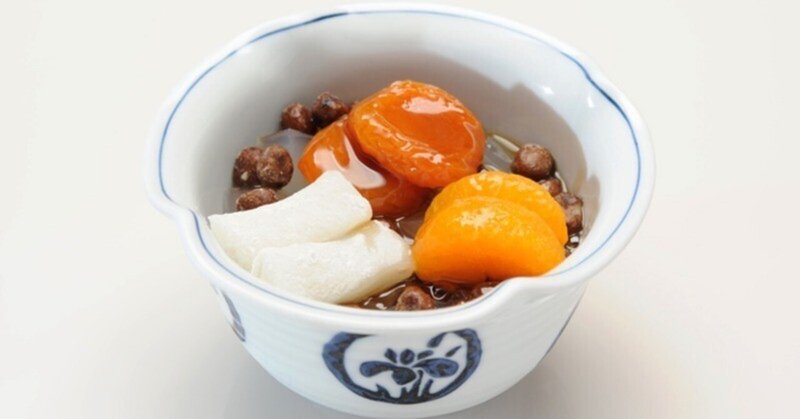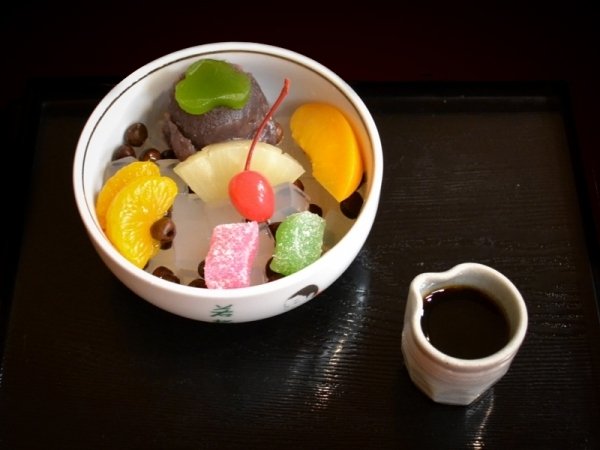
Dig Japan vol.16 “Anmitsu (あんみつ) and Mitsumame (みつまめ)”
Anmitsu (あんみつ) is wagashi made of Mitsumame (みつまめ) topped with azuki bean paste. Mitsumame is made with small dices of agar jelly, a white, translucent jelly made from red algae or seaweed, and is served in a bowl with boiled red field peas or sometimes azuki beans, often gyuhi, shiratama dango and a variety of fruits, usually canned in syrup, such as slices of peach, pieces of pineapple, cherries and mikan. Generally, a small pot of kuromitsu or molasses comes with mitsumame to pour onto the jelly before eating. Although anmitsu and mitsumame are sold in all seasons, they are especially known as a summer tradition, and are classified as a seasonal word for summer.
Mitsumame

There are various types of mitsumame, the origin of anmitsu, such as “Shiratama-mitsumame (白玉みつまめ)” which has shiratama dango on top, and “Cream-mitsumame (クリームみつまめ)” which has ice cream on top. Before tracing the history of anmitsu, let's first look at the history of mitsumame. The first shop in Japan to serve mitsumame was Funawa, which is still open in Asakusa and is also famous for its imo-yokan. During the Meiji period, Funawa was experimenting with trial and error to create sweets that adults would enjoy, and it was when mitsumame was devised. The style of dishing up small cubes of agar jelly, pieces of pineapple, apricots and mikan, and gyuhi on a modern silver bowl, then pouring syrup over the top and eating with a silver spoon was very innovative at the time. Beer halls were popular those days, so Funawa opened a high-class coffee shop with an elaborate interior called “Mitsumame Hall” and served mitsumame there.
Anmitsu

The above is the origin of mitsumame. Then, how was anmitsu created? Its origin is said to have been first served by Wakamatsu, a sweets shop still in operation in Ginza. Wakamatsu was founded in 1891, when Hanjiro Mori, who originally sold Japanese sweets in Ueno, opened a shiruko shop in Ginza. It was the second generation to develop anmitsu, and in 1930, he wondered if there was a food that could make use of the store's signature homemade bean paste, and came up with the idea of combining it with mitsumame. Wakamatsu still serves it as "Ganso-anmitsu (元祖あんみつ)" which means the original anmitsu. This is how anmitsu was devised, and it quickly became a hit and could be enjoyed all over Japan. In addition to this store, anmitsu from Kyoto, Kamakura, Asakusa, and Ueno are also famous. Besides, there is "Sumo-anmitsu (相撲あんみつ)" which is a souvenir from watching sumo matches. Like mitsumame, there are various types of anmitsu, such as "Shiratama-anmitsu (白玉あんみつ)" with shiratama dango added, and "Cream-anmitsu (クリームあんみつ)" with whipped cream on top.
This article was written by 𝐡𝐢𝐫𝐨𝐤𝐨, working as a freelance translator and press for overseas apparel brands in Japan, with the purpose of broadening her insight into the Japanese traditional culture.
いつも読んでくださってありがとうございます☺︎いただいたサポートは、記事のクオリティ向上に活用させていただきます。応援よろしくお願いします❦
